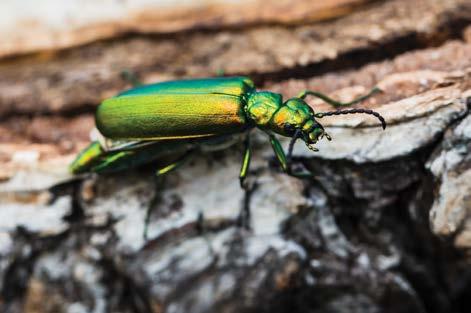
2 minute read
Emerald Ash Borer Spreads in SD, But slowly
Just in time for summer, authorities have announced that the invasive emerald ash borer (EAB) has now burrowed its way into three South Dakota counties.
The South Dakota Department of Agriculture and Natural Resources (DANR) discovered an EAB infestation earlier this year in Dakota Dunes, SD. The insect has now been confi rmed in Union, Lincoln, and Minnehaha counties since it was fi rst discovered in the state in 2018.
Advertisement
And while there’s no way of eradicating EAB’s presence from the state entirely, the DANR says having three infected counties in fi ve years is consistent with movement in other states taking a similar approach to combat the ashtree-killing insect.
That approach is a multi-county quarantine and public awareness efforts designed to help slow the spread.
“EAB will eventually spread across the state,” said Brian Walsh, Public Affairs Director for DANR. “Quarantines and public awareness efforts help slow the spread by minimizing the movement of potentially infested wood, giving landowners and communities more time to develop EAB response plans.”

EAB is an invasive boring beetle that feeds on all species of North American ash. The insect has killed tens of millions of ash trees in at least 35 states.
South Dakota has a lot of ash trees, so an unchecked spread could be devastating for communities.
According to Walsh, ash trees can be found throughout the state in most windbreaks and along many rivers and streams. They are especially prevalent in East River communities, where they account for about one third of all trees.
“Once a tree is infected it quickly becomes unstable, creating a public safety hazard,” he said. “Waiting to manage your ash trees until after they are impacted can lead to increased liability and signifi cant removal cost. Working to slow the spread helps landowners and communities plan for an infestation and act earlier to begin removing ash trees and planting replacement trees.”
Even though the spread is slow, individuals and communities should remain diligent, especially in the upcoming summer months when the beetles emerge from the wood to seek out new locations.
Visit emeraldashborerinsouthdakota. sd.gov for information on workshops, quarantines, news and current events, community and landowner guidance, along with helpful links and information about how to report a potential sighting. ■ iStock.com/alan64
The EMERALD ASH BORER (EAB) is a boring beetle that feeds on North American ash. Adults are about 1/2 inch long, slender, and a metallic green color. They normally emerge from ash trees during June or July and leave behind D-shaped exit holes about 1/8 inch in size. EAB larva feeds on the tissues underneath the bark, creating tunnels (see cover photo) which inhibit the tree's ability to transport water and nutrients leading to the death of the tree.
Help slow the spread of EAB
DON’T MOVE FIREWOOD
Burn it where you buy it. Make sure local or treated wood is available for purchase in your town.
Develop A Response Plan
For cities within the quarantine, begin or continue to treat or remove ash trees as needed. For those outside of the quarantine area, gradually remove ash trees pre-emptively and replace them with other species.
PLANT A VARIETY OF TREES.
Cities should use multiple different species to make their community trees resistant to more than one insect or disease.
Learn How To Recognize An Eab Infestation
Visit emeraldashborerinsouthdakota. sd.gov for information on workshops, quarantines, news and current events, community and landowner guidance, along with helpful links and information about how to report a potential sighting.
Educate Your Citizens
Promote public awareness of EAB, teach citizens how to recognize an infestation, and share your response plan and efforts with the public.
Follow The Quarantine Requirements
The EAB quarantine area currently includes Minnehaha, Lincoln, Turner, and Union counties. The quarantine is in effect year-round and prohibits the movement of any ash materials or fi rewood from hardwood species out of the quarantine. In addition, South Dakota has a statewide embargo in place prohibiting the movement of regulated items (ARSD 12:51:10:03) from entering the state unless certain conditions are met.










